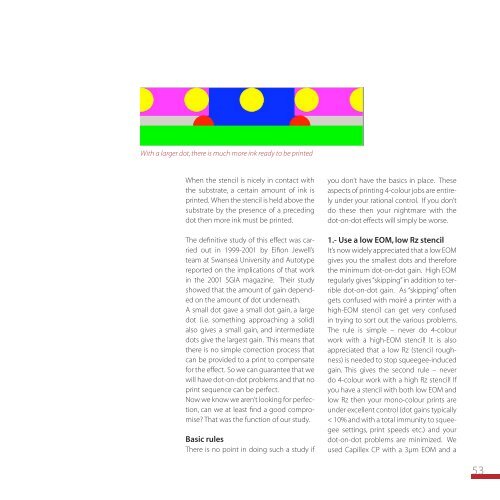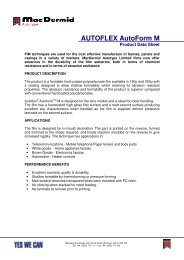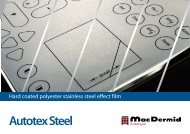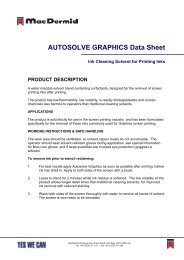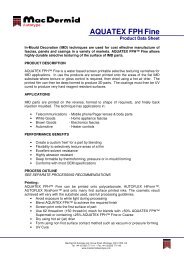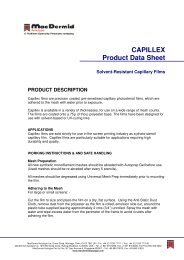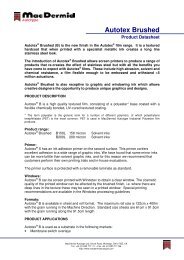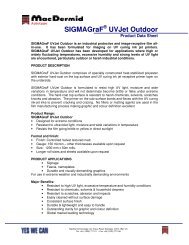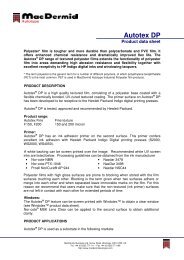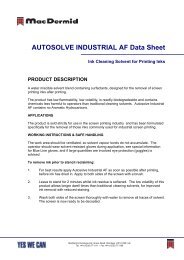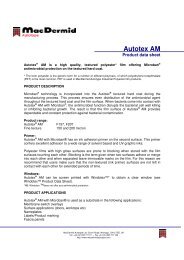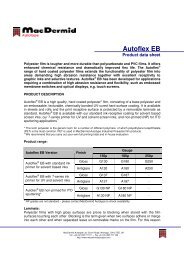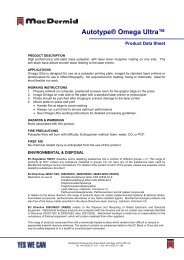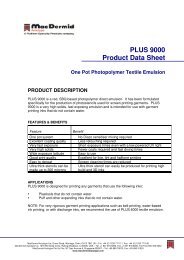Screen E-Book (.PDF) - MacDermid Autotype
Screen E-Book (.PDF) - MacDermid Autotype
Screen E-Book (.PDF) - MacDermid Autotype
- No tags were found...
You also want an ePaper? Increase the reach of your titles
YUMPU automatically turns print PDFs into web optimized ePapers that Google loves.
With a larger dot, there is much more ink ready to be printedWhen the stencil is nicely in contact withthe substrate, a certain amount of ink isprinted. When the stencil is held above thesubstrate by the presence of a precedingdot then more ink must be printed.The definitive study of this effect was carriedout in 1999-2001 by Eifion Jewell’steam at Swansea University and <strong>Autotype</strong>reported on the implications of that workin the 2001 SGIA magazine. Their studyshowed that the amount of gain dependedon the amount of dot underneath.A small dot gave a small dot gain, a largedot (i.e. something approaching a solid)also gives a small gain, and intermediatedots give the largest gain. This means thatthere is no simple correction process thatcan be provided to a print to compensatefor the effect. So we can guarantee that wewill have dot-on-dot problems and that noprint sequence can be perfect.Now we know we aren’t looking for perfection,can we at least find a good compromise?That was the function of our study.Basic rulesThere is no point in doing such a study ifyou don’t have the basics in place. Theseaspects of printing 4-colour jobs are entirelyunder your rational control. If you don’tdo these then your nightmare with thedot-on-dot effects will simply be worse.1.- Use a low EOM, low Rz stencilIt’s now widely appreciated that a low EOMgives you the smallest dots and thereforethe minimum dot-on-dot gain. High EOMregularly gives “skipping” in addition to terribledot-on-dot gain. As “skipping” oftengets confused with moiré a printer with ahigh-EOM stencil can get very confusedin trying to sort out the various problems.The rule is simple – never do 4-colourwork with a high-EOM stencil! It is alsoappreciated that a low Rz (stencil roughness)is needed to stop squeegee-inducedgain. This gives the second rule – neverdo 4-colour work with a high Rz stencil! Ifyou have a stencil with both low EOM andlow Rz then your mono-colour prints areunder excellent control (dot gains typically< 10% and with a total immunity to squeegeesettings, print speeds etc.) and yourdot-on-dot problems are minimized. Weused Capillex CP with a 3µm EOM and a53


